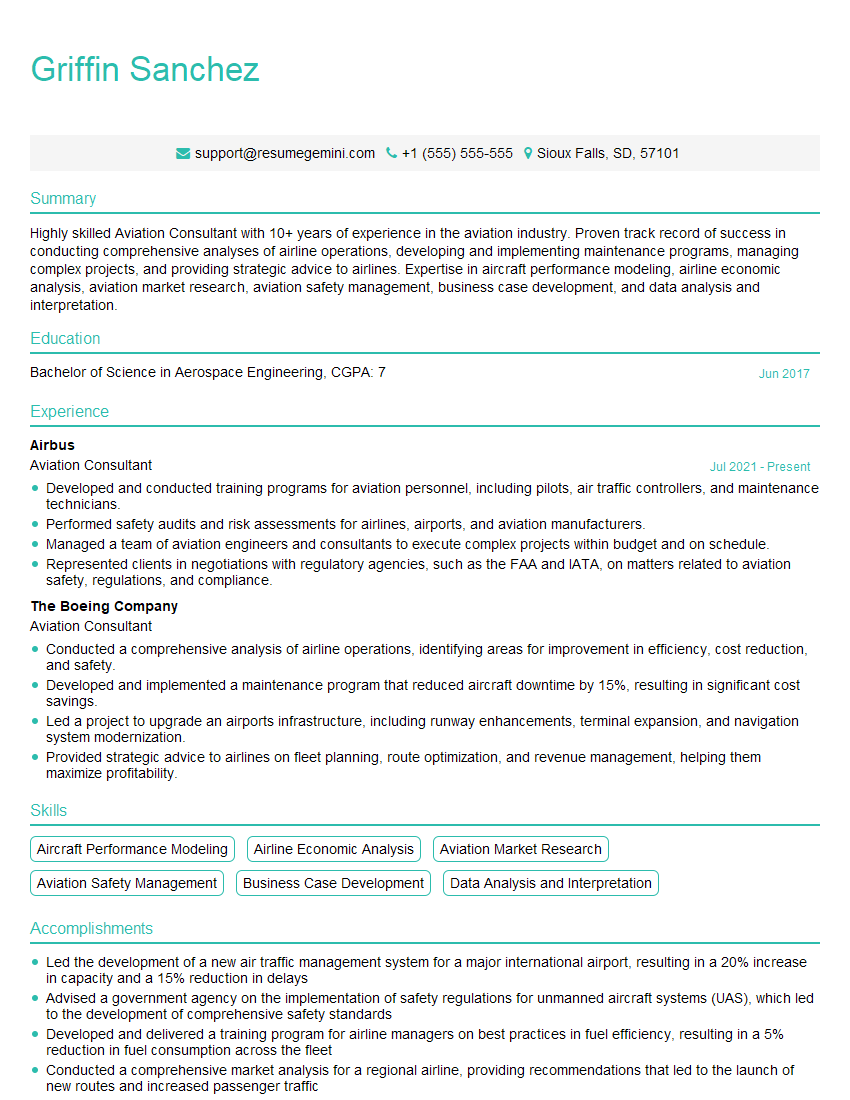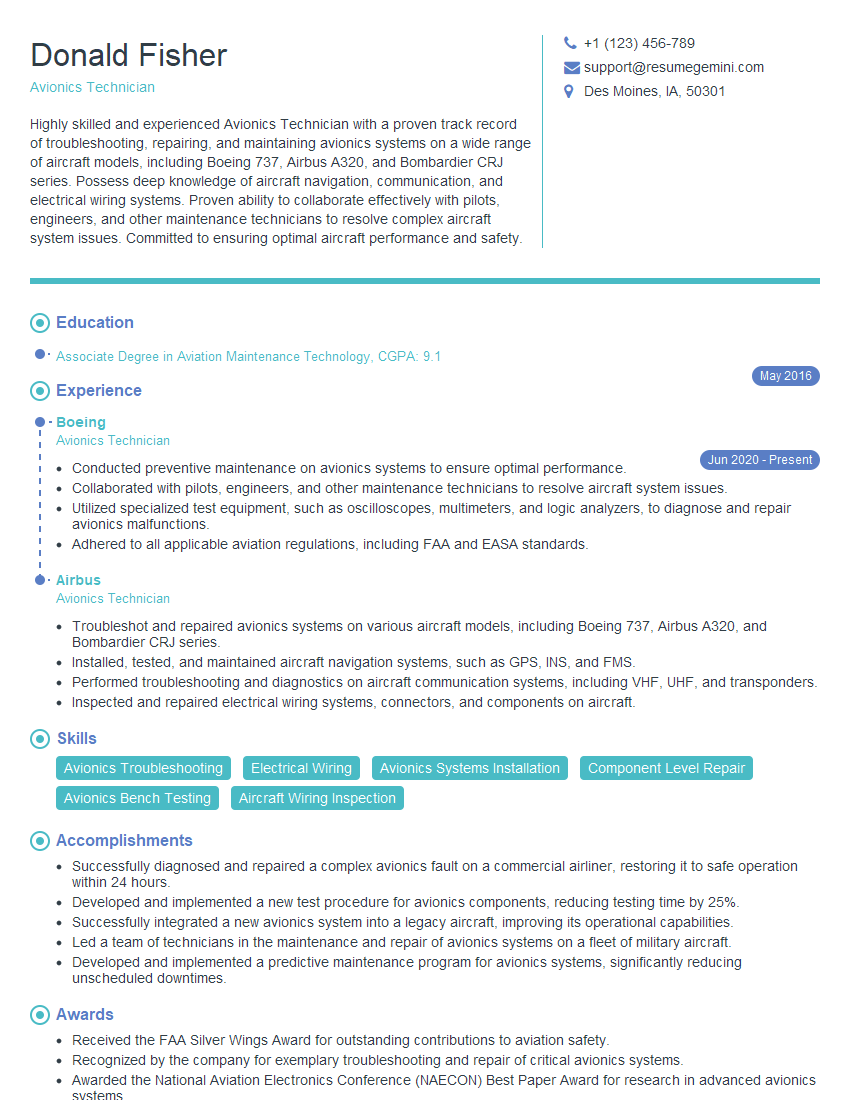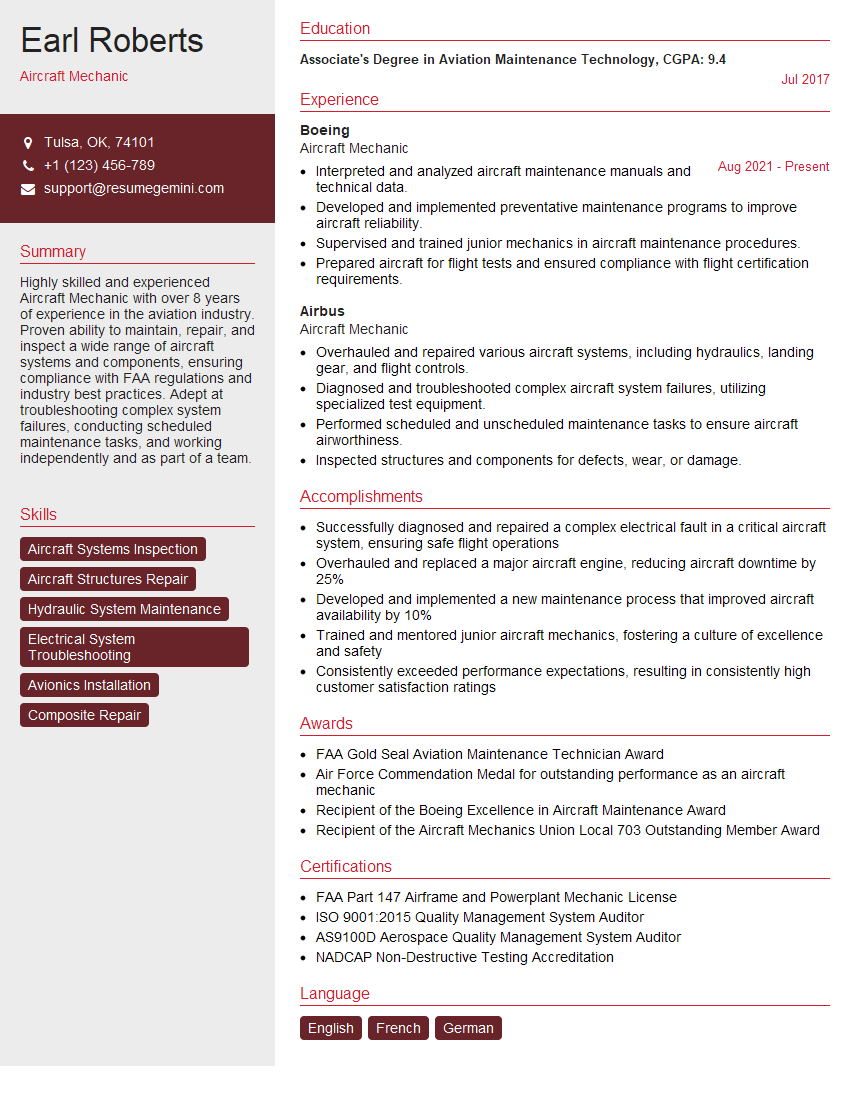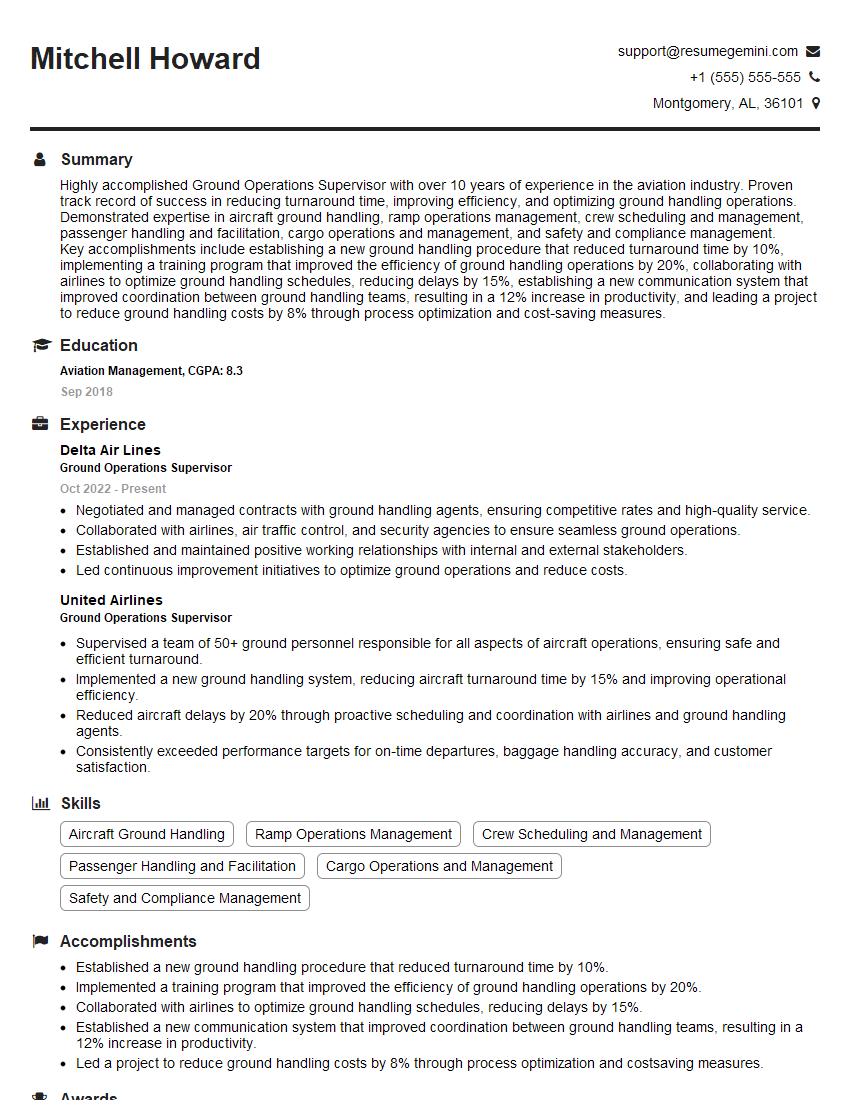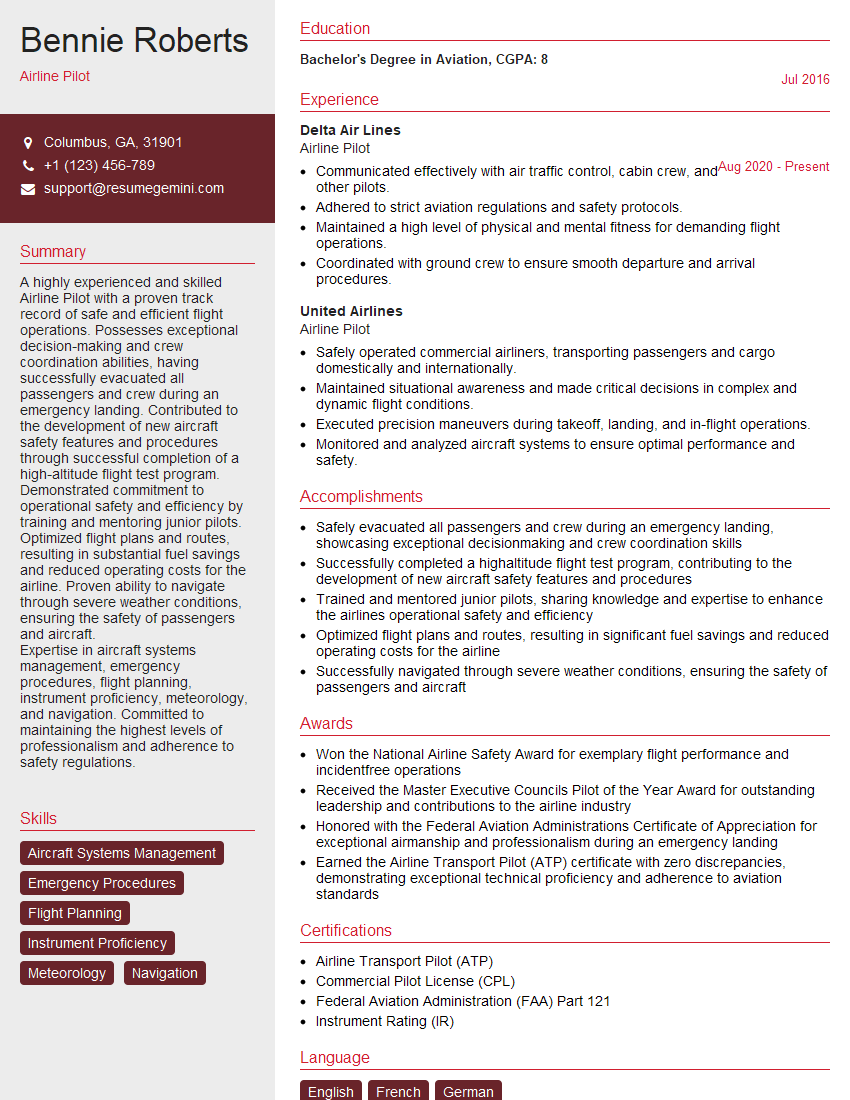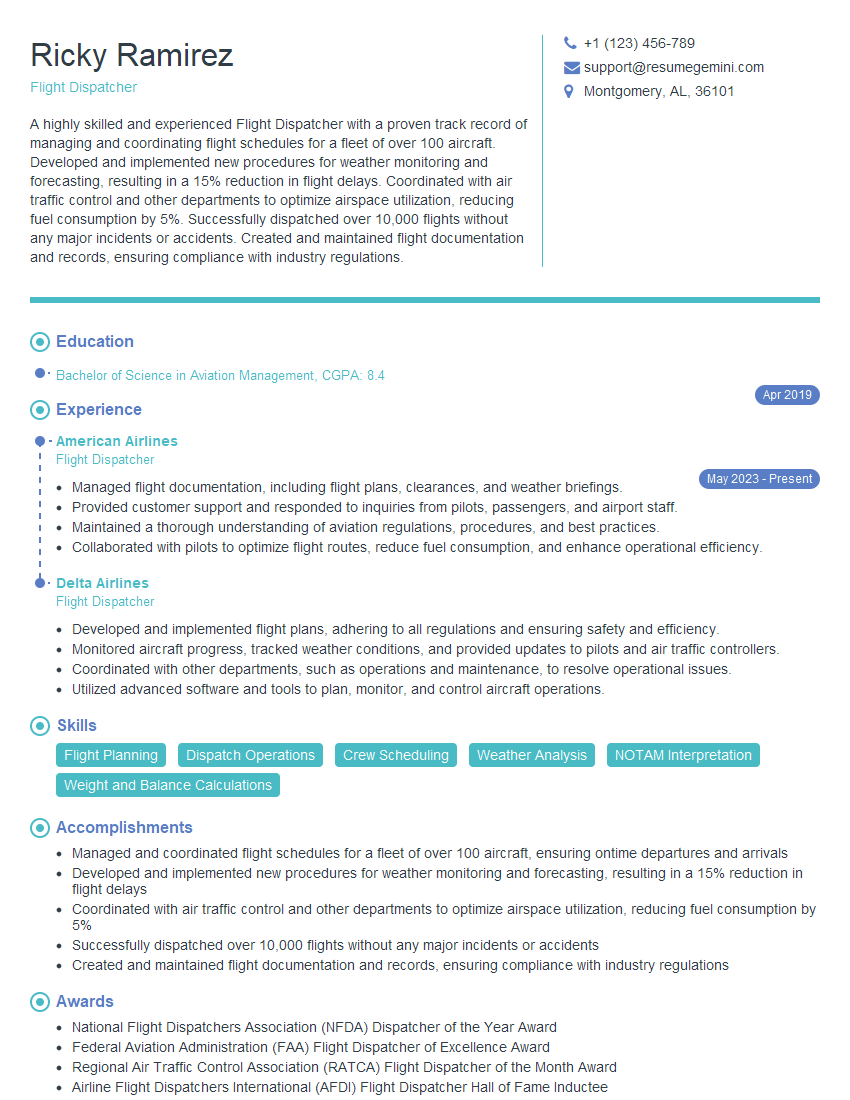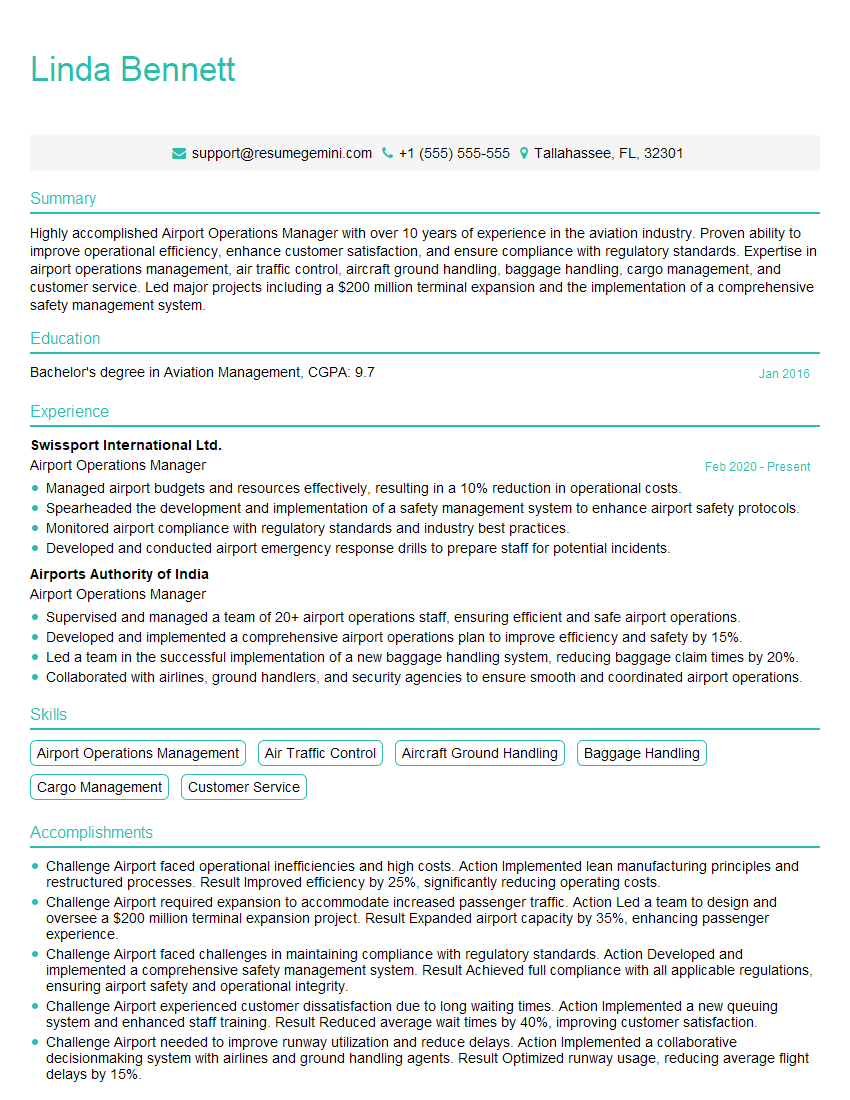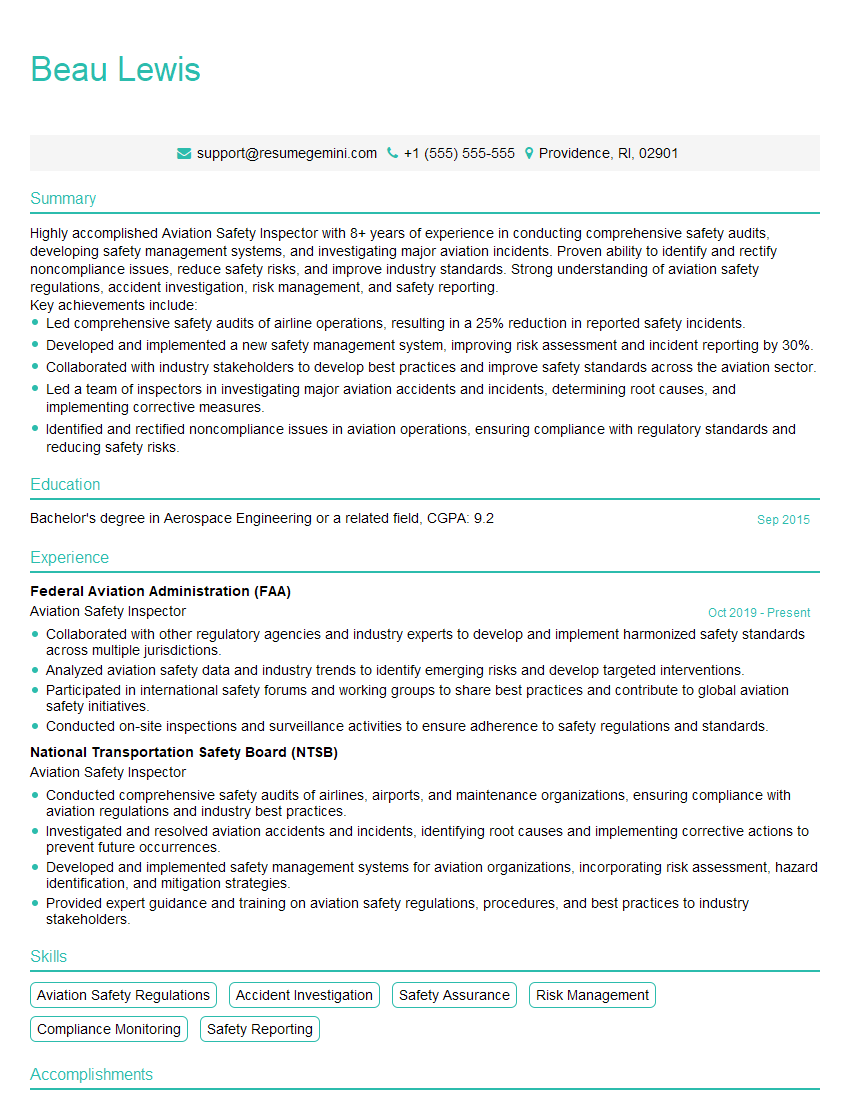Interviews are opportunities to demonstrate your expertise, and this guide is here to help you shine. Explore the essential Knowledge of Aviation Industry Standards and Practices interview questions that employers frequently ask, paired with strategies for crafting responses that set you apart from the competition.
Questions Asked in Knowledge of Aviation Industry Standards and Practices Interview
Q 1. Explain the significance of FAR Part 121.
FAR Part 121, in the United States, outlines the regulations for operating certificated air carriers and commercial operators of large airplanes. Think of it as the rulebook for airlines and large-scale air operations. It covers everything from pilot qualifications and flight operations to aircraft maintenance and safety management. It’s crucial because it ensures a high level of safety and operational reliability for commercial air travel.
Specifically, Part 121 dictates requirements for:
- Pilot certification and training: This includes rigorous flight and simulator training, recurrent training to maintain proficiency, and stringent medical standards.
- Aircraft maintenance: Detailed procedures for preventative and corrective maintenance, record-keeping, and inspections are mandated to ensure airworthiness.
- Flight operations: This encompasses aspects like dispatch, flight planning, crew resource management, and operational control to minimize risks during flight.
- Safety management systems (SMS): Part 121 emphasizes a proactive approach to safety by requiring operators to establish and maintain a comprehensive SMS.
Non-compliance with Part 121 can result in significant penalties, ranging from fines to operational suspensions and even revocation of operating certificates, illustrating its immense significance in maintaining safe and reliable air travel.
Q 2. Describe the process for reporting a safety incident.
Reporting a safety incident is critical for continuous improvement in aviation safety. The process typically involves several key steps, depending on the severity and nature of the incident. Most organizations have internal reporting systems, often integrated with SMS platforms.
Generally, the process looks like this:
- Immediate Action: If the incident involves immediate safety concerns, take immediate steps to mitigate any further risk. This might involve diverting a flight, contacting air traffic control, or securing the aircraft.
- Incident Reporting: A formal report is filed using the designated channels, often including a detailed description of the event, individuals involved, relevant data (like flight number, aircraft type, location), and any contributing factors.
- Investigation: A thorough investigation is launched to understand the root causes of the incident. This may involve interviewing witnesses, reviewing data recorders, conducting engineering analyses, and examining maintenance records.
- Corrective Actions: Based on the investigation’s findings, appropriate corrective and preventive actions are implemented to prevent similar incidents from occurring. This might involve modifying procedures, updating training programs, or addressing equipment issues.
- Follow-up and Reporting: The effectiveness of corrective actions is monitored, and periodic reports are generated to track progress and overall safety performance.
Remember, safety reporting is often confidential to encourage open and honest reporting without fear of retribution. The goal is to learn from mistakes and improve safety, not to assign blame.
Q 3. What are the key elements of a Safety Management System (SMS)?
A Safety Management System (SMS) is a proactive approach to safety, moving beyond simply reacting to incidents to actively preventing them. It’s a systematic approach to managing safety risks and improving safety performance.
The key elements of an effective SMS typically include:
- Safety Policy: A clear statement of commitment to safety from top management.
- Safety Risk Management: A systematic process for identifying, analyzing, and mitigating safety hazards. This often involves hazard identification techniques such as HAZOP (Hazard and Operability Study) or FMEA (Failure Mode and Effects Analysis).
- Safety Assurance: Monitoring and measuring the effectiveness of safety controls and identifying areas for improvement. This involves regular audits, inspections, and data analysis.
- Safety Promotion: Fostering a positive safety culture through training, communication, and promoting open reporting of safety concerns.
- Accountability: Clear roles and responsibilities for safety management at all levels of the organization.
Think of SMS as a continuous cycle of identifying hazards, assessing risks, implementing controls, monitoring effectiveness, and continuously improving safety performance. It’s not a one-time project but an ongoing commitment.
Q 4. How do you ensure compliance with FAA regulations?
Ensuring compliance with FAA regulations is paramount. It requires a multi-faceted approach involving diligent adherence to regulations, robust record-keeping, and proactive safety management.
Here’s how we achieve this:
- Understanding Regulations: Stay up-to-date on all applicable regulations and advisories. This involves actively monitoring changes and attending relevant training sessions.
- Implementing Procedures: Develop and implement comprehensive operational procedures that fully comply with regulations. These procedures should be clearly documented and readily accessible to all personnel.
- Record Keeping: Meticulous record-keeping is essential. This includes maintaining accurate logs of maintenance activities, flight records, training records, and safety reports. These records must be easily retrievable and auditable.
- Regular Inspections and Audits: Conduct regular internal audits and inspections to ensure ongoing compliance. This helps identify potential gaps and address them promptly.
- Training and Communication: Provide comprehensive training to all personnel on relevant regulations and safety procedures. Open communication is also key; employees should feel comfortable reporting potential compliance issues.
- Proactive Safety Management: Implementing a strong Safety Management System (SMS) allows for proactive hazard identification and mitigation. This reduces the likelihood of regulatory violations.
Remember, regulatory compliance isn’t just about avoiding penalties; it’s about upholding the highest safety standards for passengers and crew. It’s a continuous process requiring vigilance and commitment.
Q 5. Explain the difference between preventive and corrective maintenance.
Preventive and corrective maintenance are two essential types of aircraft maintenance, both crucial for ensuring airworthiness. However, they differ significantly in their purpose and execution.
Preventive Maintenance: This is proactive maintenance aimed at preventing failures before they occur. Think of it as routine checkups. Examples include scheduled inspections, oil changes, component replacements based on time or cycle limits, and lubrication. The goal is to catch potential issues early and avoid costly and potentially dangerous breakdowns.
Corrective Maintenance: This is reactive maintenance performed to fix a failure that has already occurred. If an aircraft component malfunctions, corrective maintenance is undertaken to repair or replace it. This could involve replacing a faulty engine part, repairing a damaged landing gear, or addressing a discovered defect during an inspection.
The difference lies in their timing and objective. Preventive maintenance is scheduled and proactive, while corrective maintenance is unscheduled and reactive. Both are vital for maintaining a safe and airworthy aircraft, and their proper documentation is crucial for compliance.
Q 6. Describe your experience with aircraft maintenance documentation.
Throughout my career, I’ve been extensively involved in aircraft maintenance documentation, understanding its critical role in ensuring compliance and safety. My experience covers various aspects, from generating and managing maintenance records to interpreting technical documentation and ensuring traceability.
I am proficient in utilizing various maintenance tracking systems, including computerized maintenance management systems (CMMS). I understand the importance of accurate and detailed record-keeping, including the meticulous logging of maintenance actions, parts used, and personnel involved. This includes the proper use of forms like work orders, maintenance logs, and discrepancy reports.
My experience also involves interpreting complex technical manuals, schematics, and service bulletins to ensure proper maintenance procedures are followed. I know how to identify and interpret airworthiness directives (ADs) and service bulletins, ensuring timely compliance. Further, I’m adept at conducting audits to verify the accuracy and completeness of maintenance documentation, ensuring regulatory compliance. Data integrity is a core part of my work and it’s essential to the safety process.
Q 7. What are your strategies for managing risk in aviation operations?
Managing risk in aviation operations requires a structured and multi-layered approach. My strategies involve a combination of proactive risk identification, mitigation planning, and ongoing monitoring.
My strategies include:
- Hazard Identification: Employing various techniques like HAZOP, FMEA, and checklists to proactively identify potential hazards across all operational areas.
- Risk Assessment: Analyzing identified hazards using a systematic framework (often involving likelihood and severity) to determine the level of risk.
- Risk Mitigation: Developing and implementing effective controls to mitigate identified risks. This might involve procedural changes, technological upgrades, training programs, or administrative controls.
- Monitoring and Review: Regularly monitoring the effectiveness of risk mitigation strategies and reviewing the risk assessment process as needed. This includes analyzing incident data and conducting safety audits.
- Safety Culture Promotion: Cultivating a strong safety culture where reporting hazards is encouraged without fear of retribution. This promotes open communication and continuous improvement.
- Emergency Response Planning: Having comprehensive plans in place to effectively manage emergencies and minimize their impact. This involves regular drills and training.
Essentially, my approach is rooted in proactive hazard identification, a robust risk assessment, carefully chosen mitigation strategies, and a dedication to ongoing monitoring and improvement. This systematic approach is vital for maintaining a safe and reliable aviation operation.
Q 8. How familiar are you with ETOPS regulations?
ETOPS, or Extended-range Twin-engine Operations, refers to the regulations and operational procedures that allow twin-engine aircraft to fly over oceans and remote areas beyond a specified distance from an airport capable of providing an adequate emergency landing. These regulations are crucial for safety and efficiency in long-haul flights.
My familiarity with ETOPS is extensive. I understand the various ETOPS stages (ETOPS 75, ETOPS 120, ETOPS 180, etc.), each representing the maximum distance (in minutes) from a suitable diversion airport. This distance is directly related to the aircraft’s reliability, the availability of appropriate airports along the route, and the performance of the aircraft’s engines and systems. I’m also familiar with the rigorous certification processes involved in achieving ETOPS approval, including extensive testing and analysis of engine reliability, flight planning considerations, and the training requirements for pilots and maintenance personnel.
For example, an airline operating ETOPS 180 flights must demonstrate a very high level of engine reliability and have meticulously planned routes with sufficient diversion airports within 180 minutes of flight time. This requires detailed analysis of weather patterns, potential mechanical issues, and emergency procedures.
Q 9. Explain the importance of human factors in aviation safety.
Human factors are paramount in aviation safety. They encompass all aspects of human performance and behavior that influence the safety and efficiency of air operations. This includes not only pilot skills and decision-making but also the design of the cockpit, communication protocols, air traffic control procedures, and the overall organizational culture of the airline and air navigation service providers.
Consider, for example, pilot fatigue. Inadequate rest can significantly impair a pilot’s judgment and reaction time, increasing the risk of errors. Similarly, poor communication between crew members or between the crew and air traffic control can lead to misunderstandings and potentially hazardous situations. Human factors experts work to identify and mitigate these risks through improved training, more ergonomic cockpit designs, standardized procedures, and the implementation of effective safety management systems.
A key aspect is CRM (Crew Resource Management), which focuses on teamwork, effective communication, and leadership in the cockpit. This allows crews to better handle stressful situations, identify and address potential errors, and avoid accidents by harnessing the combined expertise and experience of the flight crew.
Q 10. Describe your understanding of load balancing and weight and balance calculations.
Load balancing and weight and balance calculations are critical for ensuring the safe and efficient operation of an aircraft. Weight and balance calculations determine the center of gravity (CG) of the aircraft, which must remain within pre-defined limits for safe flight. Load balancing involves distributing the weight of passengers, cargo, and fuel to achieve this optimal CG.
The process typically involves using specialized software or charts to input the weight of different components and their locations within the aircraft. This calculation determines if the aircraft’s CG is within the approved limits. An unbalanced aircraft can be difficult to control, potentially leading to instability and loss of control. Factors considered include the aircraft’s maximum takeoff weight, the weight of fuel, passengers, cargo, and baggage.
For example, if the CG is too far forward, the aircraft might be prone to nose-heaviness and stall at higher speeds. Conversely, if it’s too far aft, it could make the aircraft prone to tail-heaviness and uncontrollable pitching. Careful calculation and balancing are essential to prevent these dangerous scenarios.
Q 11. How would you handle a discrepancy found during a pre-flight inspection?
Upon discovering a discrepancy during a pre-flight inspection, my actions would follow a well-defined procedure that prioritizes safety. First, I would accurately document the discrepancy in the aircraft’s logbook or maintenance tracking system, including a detailed description of the issue, its location, and the date and time of discovery.
Next, I would assess the severity of the discrepancy. Is it a minor issue that can be deferred to a later scheduled maintenance check, or is it a critical safety item that requires immediate attention before flight? My decision would be based on the relevant maintenance manuals and regulatory requirements, as well as my own technical expertise.
If the discrepancy is minor and can be deferred, I would clearly document this decision in the logbook. If the issue is significant, I would immediately notify the appropriate maintenance personnel and ground crew to initiate corrective action. The flight would be delayed or canceled until the problem is resolved and the aircraft is deemed airworthy. Safety always comes first; operational efficiency is secondary to ensuring safe flight.
Q 12. What is your understanding of aircraft certification?
Aircraft certification is a rigorous process undertaken by aviation authorities to ensure that an aircraft design and its manufacturing process meet specific safety standards. This process involves a comprehensive series of tests and inspections to verify that the aircraft is airworthy and meets the required performance, structural, and operational standards.
Certification typically involves several phases, starting with design reviews and culminating in flight testing and certification by the relevant authority (like the FAA in the US or EASA in Europe). The aircraft must meet various criteria, including performance in different flight conditions (takeoff, landing, cruise), structural strength and fatigue resistance, and the functionality and reliability of all systems and components.
The certificate issued by the aviation authority confirms that the aircraft is safe for flight and is authorized to operate according to the specified conditions. Different types of certificates exist, each having specific operating limitations and restrictions. For example, a type certificate confirms the design is airworthy, while a production certificate ensures that each manufactured aircraft conforms to the approved design.
Q 13. Explain your knowledge of different types of aircraft maintenance checks (A, B, C, D checks).
Aircraft maintenance checks are categorized into different levels (A, B, C, D checks) based on the depth and scope of the inspection and maintenance activities. This tiered system is designed to optimize maintenance efficiency while ensuring continuous airworthiness.
- A-Checks: These are the most frequent and least extensive checks, often conducted daily or after every flight. They involve visual inspections, functional checks, and minor maintenance tasks.
- B-Checks: More extensive than A-checks, B-checks are usually performed every few weeks or months. They include more in-depth inspections of specific systems and components.
- C-Checks: These are more comprehensive and less frequent, taking several days or weeks to complete. They involve detailed inspections, removal, and replacement of components, and often require specialized equipment and personnel.
- D-Checks: This is the most extensive and least frequent check, essentially a major overhaul of the aircraft. They involve the complete disassembly and inspection of major aircraft systems and structures. D-checks often extend over several months.
The specific tasks and frequency of each check are determined by the aircraft type, its operational history, and the relevant maintenance manuals. This structured approach ensures that aircraft are maintained to the highest safety standards.
Q 14. How would you address a conflict between operational efficiency and safety compliance?
Conflicts between operational efficiency and safety compliance are sometimes unavoidable in the aviation industry. The key is to prioritize safety without unnecessarily compromising efficiency. This involves a careful risk assessment and a proactive approach to problem-solving.
In such situations, I would start by clearly identifying the conflicting elements and assessing the risks associated with each option. I would gather all relevant data, including operational constraints, safety regulations, and potential consequences of both choices. A thorough cost-benefit analysis would also be conducted, weighing the potential financial implications against the risks to safety.
Ultimately, the decision should be based on a well-informed and reasoned approach that prioritizes safety. If a compromise is necessary, it should be carefully documented and reviewed to ensure that the safety margin is not compromised. This might involve implementing additional safety measures to mitigate any identified risks associated with the chosen solution. Open communication and collaboration among all stakeholders are crucial in making an informed and balanced decision.
Q 15. What are the key performance indicators (KPIs) for aviation safety?
Aviation safety KPIs are crucial metrics used to monitor and improve safety performance. They provide a quantifiable measure of an airline or aviation organization’s effectiveness in mitigating risks. Key indicators can be grouped into several categories:
Accident Rates: This includes the number of fatal accidents, serious incidents (those that could have led to an accident), and accidents per million flight hours or flights operated. Lower rates indicate improved safety.
Incident Reporting Rates: A high rate of voluntary incident reporting suggests a culture of safety where personnel feel comfortable reporting near-misses without fear of reprisal. Analyzing these reports helps proactively identify potential hazards.
Maintenance KPIs: These track the effectiveness of maintenance programs. Examples include mean time between failures (MTBF), mean time to repair (MTTR), and the number of maintenance-related discrepancies found during inspections.
Flight Operation KPIs: Metrics like runway incursions, near-mid-air collisions (NMAC), and deviations from standard operating procedures (SOPs) reflect the safety of flight operations. A decrease indicates improved adherence to safety protocols.
Training and Competency KPIs: This category measures the effectiveness of training programs, including the completion rates of training courses, the proficiency levels demonstrated in recurrent training, and the number of training-related errors.
Safety Audits and Inspections Results: The number of safety deficiencies identified during audits and inspections and the time taken to rectify them, alongside the effectiveness of corrective actions, provides insight into overall safety management systems (SMS).
These KPIs, when analyzed together, give a comprehensive picture of an organization’s safety performance, allowing for focused improvement efforts.
Career Expert Tips:
- Ace those interviews! Prepare effectively by reviewing the Top 50 Most Common Interview Questions on ResumeGemini.
- Navigate your job search with confidence! Explore a wide range of Career Tips on ResumeGemini. Learn about common challenges and recommendations to overcome them.
- Craft the perfect resume! Master the Art of Resume Writing with ResumeGemini’s guide. Showcase your unique qualifications and achievements effectively.
- Don’t miss out on holiday savings! Build your dream resume with ResumeGemini’s ATS optimized templates.
Q 16. Explain your experience with aviation-related auditing and inspections.
Throughout my career, I’ve been extensively involved in aviation-related auditing and inspections, focusing on both maintenance and operational aspects. I’ve participated in numerous audits conducted in accordance with industry best practices and regulatory requirements, including those aligned with ICAO standards and national aviation authorities’ regulations. My experience encompasses:
Maintenance Audits: I’ve audited maintenance organizations (MROs) and airlines, verifying compliance with maintenance manuals, regulatory requirements (e.g., Part 145, EASA Part-M), and the effective implementation of their SMS. This involves reviewing maintenance records, inspecting workshops, and interviewing personnel to assess their competency and adherence to procedures. A recent audit I performed led to the identification of a critical deficiency in their record-keeping procedures, which if left unaddressed could have compromised aircraft safety. We developed a corrective action plan to remediate the deficiency, leading to significant improvements.
Operational Audits: I’ve conducted operational audits assessing compliance with operational control procedures, flight dispatching practices, crew resource management (CRM) implementation, and safety reporting systems. This involves reviewing flight data recorders (FDRs), flight plans, and crew performance records.
Safety Management System (SMS) Audits: I have experience auditing the effectiveness of an organization’s SMS, evaluating its hazard identification, risk assessment, and risk mitigation processes. This includes assessing their safety policy, safety reporting systems, and safety promotion activities.
My audit reports are detailed, objective, and provide constructive recommendations for continuous improvement. I am proficient in using various audit methodologies, ensuring a thorough and comprehensive evaluation of safety performance.
Q 17. Describe your understanding of the ICAO standards.
The International Civil Aviation Organization (ICAO) sets global standards and recommended practices for international air navigation. My understanding of ICAO standards is extensive and covers various aspects of aviation safety, security, and efficiency. These standards are crucial for ensuring consistency and interoperability in the global aviation system. Key areas include:
Annex 6 – Operation of Aircraft: This covers flight crew licensing, flight operations, airworthiness, and the overall safe operation of aircraft. I am familiar with its detailed requirements for flight planning, dispatch, and operational procedures.
Annex 8 – Airworthiness of Aircraft: This outlines the standards for the design, manufacture, maintenance, and certification of aircraft to ensure they are airworthy and safe for operation. I understand its requirements for airworthiness inspections and continuing airworthiness management.
Annex 14 – Aerodromes: This provides standards for the design, construction, maintenance, and operation of aerodromes, ensuring safe and efficient ground operations.
Annex 17 – Security: This deals with aviation security, outlining measures to protect civil aviation against acts of unlawful interference. I am aware of the importance of adhering to security procedures and protocols.
Safety Management Systems (SMS): ICAO strongly promotes the implementation of SMS, a proactive approach to managing safety risks. I understand the principles of SMS and its application in various aviation organizations.
Compliance with ICAO standards is essential for international flights and often forms the basis of national aviation regulations. I’m adept at interpreting and applying these standards in practical scenarios to ensure the highest levels of safety.
Q 18. How do you ensure that all maintenance personnel are properly trained and certified?
Ensuring properly trained and certified maintenance personnel is paramount to aviation safety. This involves a multi-faceted approach:
Initial Training: Personnel undergo comprehensive initial training programs that cover the theoretical and practical aspects of aircraft maintenance, specific to their assigned tasks. This training must meet regulatory requirements (e.g., Part 66 for EASA, FAA Part 147 for the USA).
Certification: Upon successful completion of initial training, individuals receive appropriate licenses or certifications to perform specific maintenance tasks. These certifications are issued by national aviation authorities and often require periodic renewal.
Continuing Professional Development (CPD): Ongoing training and development are crucial to maintaining competence. This includes recurrent training, specialized courses, and updates on new technologies and procedures. We track all CPD to ensure continuous compliance and skill improvement.
Competency Assessments: Regular competency assessments, including practical examinations and theoretical tests, are conducted to ensure maintenance personnel consistently meet the required standards. Performance reviews and oversight by supervisors are also integral to this process.
Training Records Management: Meticulous record-keeping is vital to demonstrate compliance with regulatory requirements. All training, certification, and competency assessment records are meticulously documented and readily available for audits.
A robust training program, coupled with a strong emphasis on competency assessment and record-keeping, ensures that maintenance personnel are equipped with the knowledge and skills necessary to perform their tasks safely and efficiently.
Q 19. What is your understanding of the various types of aircraft accidents and their causes?
Aircraft accidents are complex events, rarely caused by a single factor. They are often the result of a chain of events, a combination of contributing factors, and failures in the system. Understanding these factors is critical to accident prevention. Types and causes include:
Flight Control Failures: These can stem from mechanical malfunctions, pilot error (e.g., incorrect control inputs), or a combination of both. Regular maintenance and rigorous pilot training are essential to mitigating these risks. For example, a failure of the flight control system’s actuator can lead to loss of control.
Human Factors: Pilot error, air traffic control errors, maintenance errors, and communication breakdowns are significant contributing factors. Improved training, better crew resource management (CRM), and effective safety management systems (SMS) address these challenges.
Weather-Related Accidents: Adverse weather conditions like icing, turbulence, and reduced visibility can significantly impact flight safety. Pilots require adequate training and decision-making skills to manage challenging weather. Accurate weather forecasting and reporting are also crucial.
Mechanical Failures: Engine failures, structural failures, and other component failures can contribute to accidents. Stringent maintenance practices, effective inspections, and robust airworthiness management are necessary to reduce these risks.
Controlled Flight Into Terrain (CFIT): This occurs when an airworthy aircraft is flown under the control of its pilot into terrain, which often results from poor situational awareness and inadequate navigation. Technology like terrain awareness and warning systems (TAWS) plays a crucial role in preventing such accidents.
Accident investigations utilize a systematic approach, often involving the collection of data from flight recorders, witness accounts, and wreckage analysis to identify contributing factors and recommend safety improvements.
Q 20. Explain your experience with emergency procedures and response plans.
My experience with emergency procedures and response plans includes both development and implementation. I’ve been involved in creating and reviewing emergency response plans for airports and airlines, ensuring compliance with regulatory requirements and industry best practices. This involves:
Emergency Response Plan Development: This includes the definition of roles and responsibilities, communication protocols, emergency equipment deployment, and evacuation procedures. I’ve worked on plans considering different scenarios, including aircraft accidents, security threats, and natural disasters.
Emergency Drills and Exercises: I’ve participated in numerous emergency drills and exercises, evaluating the effectiveness of the response plans and identifying areas for improvement. These drills involve simulating various emergency scenarios and assess the preparedness of personnel involved in the response.
Emergency Equipment Maintenance and Inspection: I’ve overseen the maintenance and inspection of emergency equipment, including fire suppression systems, emergency escape slides, and medical equipment, ensuring their readiness for use. Regular inspection and servicing of this equipment ensures that it is always functional when needed.
Post-Incident Analysis: In the event of an actual emergency, I have participated in post-incident analyses to learn lessons and improve future emergency preparedness. Thorough review of events and post-incident evaluations help identify areas needing improvement and strengthen the existing plan.
A well-defined emergency response plan is crucial in ensuring the safety and efficient management of any emergency situation in the aviation industry, effectively mitigating its impact on personnel and operations.
Q 21. Describe your knowledge of aviation meteorological information and its impact on flight operations.
Aviation meteorological information is critical for safe and efficient flight operations. My understanding encompasses various aspects:
Sources of Meteorological Information: Pilots and flight dispatchers rely on various sources, including meteorological services (e.g., national meteorological agencies), aviation weather briefings, and in-flight weather radar.
Types of Meteorological Information: This includes surface weather observations, upper-air data (e.g., wind, temperature, and humidity at different altitudes), weather forecasts, and significant weather phenomena warnings (e.g., thunderstorms, icing, turbulence).
Impact on Flight Operations: Meteorological information directly impacts flight planning, routing, and in-flight decisions. Adverse weather conditions may lead to flight delays, diversions, or cancellations to ensure safety. For example, strong headwinds can significantly affect fuel consumption and flight time, while turbulence can lead to passenger discomfort and potential damage to the aircraft.
Decision-Making Based on Meteorological Information: Pilots and flight dispatchers must effectively interpret meteorological information to make informed decisions regarding flight safety. This includes assessing the risks associated with various weather conditions and selecting appropriate flight plans and procedures.
Technology and Meteorological Information: Modern technology plays a significant role, with advanced weather radar systems providing real-time information in-flight. Satellite imagery and numerical weather prediction models also enhance the accuracy and timeliness of weather information.
Understanding and effectively using meteorological information is a crucial element of maintaining aviation safety and optimizing flight operations.
Q 22. How familiar are you with the use of flight data recorders (FDRs) and cockpit voice recorders (CVRs)?
Flight Data Recorders (FDRs) and Cockpit Voice Recorders (CVRs) are crucial components of aviation safety, acting as black boxes that record various flight parameters and cockpit conversations respectively. I’m intimately familiar with their operation, data retrieval, and analysis.
FDRs record a multitude of parameters, including airspeed, altitude, heading, vertical acceleration, engine performance data, and control surface positions. This data is invaluable in accident investigations, helping to determine the sequence of events leading up to an incident. Think of it as a highly detailed flight log, providing a precise picture of the aircraft’s behavior.
CVRs, on the other hand, record the conversations in the cockpit, along with ambient sounds. This can be incredibly useful in understanding the crew’s actions and decision-making processes during critical phases of flight. It allows investigators to hear the communications between pilots, air traffic control, and other crew members. For instance, it might reveal a miscommunication that led to a near-miss.
My experience encompasses not only understanding the data these recorders capture but also interpreting that data, using specialized software to analyze trends, identify anomalies, and contribute to safety recommendations. I understand the regulations surrounding their installation, maintenance, and retrieval, including the standards outlined by organizations like the NTSB (National Transportation Safety Board) and ICAO (International Civil Aviation Organization).
Q 23. Explain your understanding of air traffic control procedures.
Air Traffic Control (ATC) procedures are a complex system designed to ensure the safe, orderly, and efficient flow of air traffic. My understanding encompasses various aspects, from basic principles to advanced procedures used in high-density airspace.
At its core, ATC relies on communication, coordination, and separation. Controllers use radar and other technologies to track aircraft movements and provide instructions to pilots, ensuring that sufficient separation is maintained between aircraft to prevent collisions. This separation is achieved through vertical and horizontal separation, altitude assignments, and route clearances.
- Communication: Pilots and controllers utilize standardized phraseology to ensure clear and unambiguous communication. This is crucial in preventing misunderstandings that could lead to accidents.
- Navigation: Pilots use various navigation aids, such as VORs (Very High Frequency Omnidirectional Range), ILS (Instrument Landing System), and GPS, to follow assigned routes and maintain their positions.
- Separation: ATC employs a variety of techniques to maintain separation, including time-based separation (for aircraft following each other on the same route), and altitude-based separation (maintaining vertical distance between aircraft).
I’m familiar with different classes of airspace, each with its own specific rules and regulations, including Controlled Airspace (Class A-E) and Uncontrolled Airspace (Class G). My understanding extends to emergency procedures, instrument flight rules (IFR), and visual flight rules (VFR), as well as various weather-related procedures that impact flight operations.
For example, I understand how controllers manage traffic flow during periods of inclement weather, diverting flights or implementing ground delays to maintain safety.
Q 24. What is your understanding of the role of airworthiness certificates?
Airworthiness certificates are official documents issued by aviation authorities, certifying that an aircraft meets specific safety standards and is fit for flight. They’re essential for legal operation of any aircraft. The process involves rigorous inspections and verification to ensure compliance with regulations.
These certificates demonstrate that the aircraft has undergone the necessary maintenance, inspections, and modifications to ensure its airworthiness. Different types of certificates exist depending on the aircraft’s intended use and type of operation. The process often involves regular maintenance checks, inspections by certified mechanics and periodic audits by aviation authorities. Think of it like a driver’s license for an aircraft, proving its eligibility to operate legally.
Failure to maintain an airworthiness certificate or operate an aircraft in a manner consistent with its specifications can result in serious legal consequences, including grounding of the aircraft and potential penalties for the operator.
My understanding extends to the different categories of airworthiness certificates and the specific requirements for each type, including the documentation and record-keeping processes involved.
Q 25. Describe your experience with risk assessment and mitigation in aviation.
Risk assessment and mitigation are fundamental to aviation safety. My experience involves applying structured methodologies to identify, analyze, and control potential hazards throughout the entire lifecycle of aviation operations.
I utilize techniques such as Hazard Identification (HAZID) studies, Fault Tree Analysis (FTA), and Failure Mode and Effects Analysis (FMEA) to systematically identify potential hazards, assess their likelihood and severity, and determine appropriate mitigation strategies. For example, a HAZID study might reveal that bird strikes pose a significant risk at a particular airport. Mitigation strategies could then include measures such as implementing bird control programs and modifying takeoff and landing procedures.
My experience includes developing risk mitigation plans that outline specific actions to reduce the likelihood or severity of identified risks. This can involve implementing new procedures, investing in safety equipment, or providing additional training for personnel. I also understand the importance of monitoring and reviewing the effectiveness of implemented risk mitigation strategies and adapting them as needed.
A practical example: During a project involving the implementation of a new flight management system, I led a risk assessment exercise to identify potential risks associated with the transition. This involved considering risks related to software glitches, pilot training, and data migration. We developed a detailed mitigation plan that included robust testing, comprehensive training, and contingency plans for potential system failures.
Q 26. How would you communicate effectively with different stakeholders in an aviation environment?
Effective communication is paramount in the aviation industry, where multiple stakeholders with diverse backgrounds and expertise are involved. My approach focuses on clarity, accuracy, and empathy to foster collaboration and build trust.
I adapt my communication style to the audience. When communicating with pilots, I use precise and concise language, focusing on operational aspects and safety procedures. With engineers, I delve into technical details, ensuring clear understanding of system functionalities and potential risks. When communicating with management, I present information in a clear and concise manner, emphasizing the key findings and recommendations.
I’m skilled in both written and verbal communication, utilizing various methods such as briefings, reports, presentations, and meetings to ensure efficient information flow. Active listening is a key component of my approach, allowing me to fully understand the perspective of others and respond appropriately. Clear and concise reporting, using data visualization techniques where appropriate, helps ensure information is easily understood.
For example, during a safety investigation, I successfully communicated complex technical findings to both technical and non-technical audiences, ensuring all parties understood the root causes of the incident and the recommended safety improvements.
Q 27. What are your strategies for continuous improvement in aviation safety and compliance?
Continuous improvement in aviation safety and compliance is an ongoing process that demands a proactive and data-driven approach. My strategies focus on leveraging data analysis, proactive risk management, and embracing a culture of safety.
Data-driven analysis: I regularly analyze safety data, including accident reports, incident reports, and operational data, to identify trends and areas needing improvement. This data-driven approach allows for targeted interventions and resource allocation. For instance, if data shows a high rate of near-miss incidents related to a specific procedure, we can revise that procedure to enhance safety.
Proactive Risk Management: Proactive risk management involves identifying and mitigating potential hazards before they result in incidents. This includes regularly reviewing and updating safety management systems, conducting safety audits and inspections, and implementing new technologies that enhance safety. The implementation of safety management systems (SMS) is crucial for this process.
Safety Culture: Fostering a strong safety culture is paramount. This involves encouraging open communication, promoting reporting of safety concerns without fear of retribution, and providing training and resources to empower employees to actively participate in safety improvement initiatives. Regular safety meetings and training sessions help reinforce the importance of safety and build a culture where safety is everyone’s priority.
Regularly reviewing and updating safety procedures based on lessons learned from incidents and industry best practices, combined with continuous monitoring of performance indicators, ensures consistent improvement in safety and compliance.
Key Topics to Learn for Knowledge of Aviation Industry Standards and Practices Interview
- Aviation Safety Regulations: Understand key regulations like FARs (Federal Aviation Regulations) or equivalent international standards. Explore how these regulations impact daily operations and maintenance procedures.
- Aircraft Maintenance and Repair: Familiarize yourself with the principles of aircraft maintenance, including preventative maintenance programs, troubleshooting techniques, and the documentation involved. Consider practical applications like interpreting maintenance manuals and understanding the significance of aircraft logs.
- Airworthiness Directives (ADs): Learn about the process of issuing and complying with ADs, their importance for flight safety, and the potential consequences of non-compliance.
- Human Factors in Aviation: Understand the role of human factors in aviation safety, including crew resource management (CRM), fatigue management, and the impact of stress on decision-making.
- Aviation Meteorology: Develop a working knowledge of weather phenomena relevant to aviation, including their impact on flight operations and safety. Consider practical application in flight planning and decision-making.
- Navigation Systems and Procedures: Understand various navigation systems (e.g., GPS, VOR, ILS) and their application in flight planning and execution. Be prepared to discuss practical navigation scenarios and problem-solving.
- Emergency Procedures and Response: Familiarize yourself with emergency procedures for various scenarios, including engine failure, loss of communication, and emergency landings. Consider the theoretical concepts and their practical application in real-world situations.
- Quality Assurance and Safety Management Systems (SMS): Understand the principles of quality assurance and safety management systems within the aviation industry, including their role in risk mitigation and continuous improvement.
Next Steps
Mastering Knowledge of Aviation Industry Standards and Practices is crucial for career advancement in this highly regulated field. A strong understanding of these topics demonstrates your commitment to safety and your ability to contribute effectively to a team. To maximize your job prospects, creating an ATS-friendly resume is essential. ResumeGemini can help you build a professional and impactful resume that showcases your skills and experience effectively. Examples of resumes tailored to the Knowledge of Aviation Industry Standards and Practices are available to help you build your own compelling application.
Explore more articles
Users Rating of Our Blogs
Share Your Experience
We value your feedback! Please rate our content and share your thoughts (optional).
What Readers Say About Our Blog
Hi, I’m Jay, we have a few potential clients that are interested in your services, thought you might be a good fit. I’d love to talk about the details, when do you have time to talk?
Best,
Jay
Founder | CEO

